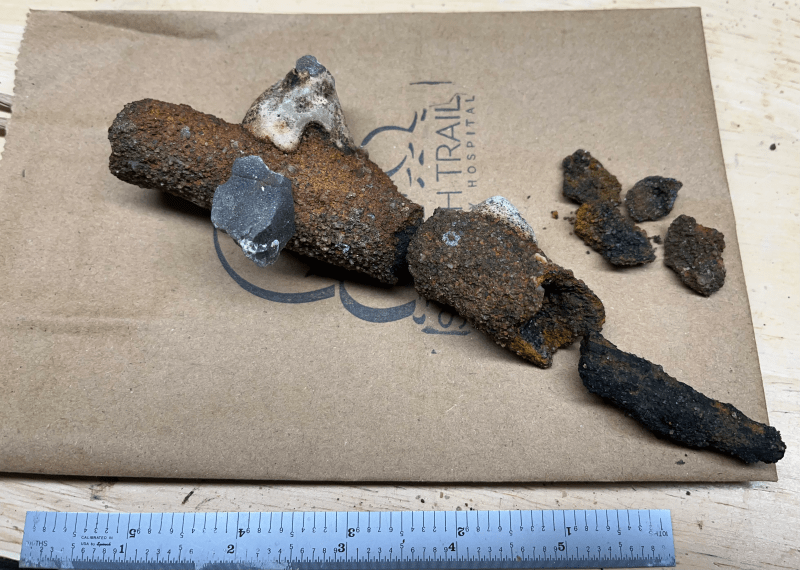Larry Smith
Aerospace
- Apr 2, 2024
- 6
Hi. I'm a retired helicopter engineer that's taken on a project to analyze concretions found in the bay. I can tell they contain iron because they attract to a magnet. One looks like it might be a ship spike, the other was on a small plank (either side of nail hole). I imagine that they might be from an old shipwreck, I just don't know how old. I had them xrf analyzed and results are confusing me since, in addition to lots of iron oxide Fe2O3 and silicon oxide SiO2, there's many elements present including Cu, Zn, and Sn plus several race amounts of REEs. Is it possible that my xrf data can be interpreted to correlate when items were made? My target period is 16th century. It's beyond my area of expertise so I'm hoping someone on this forum has understanding of what was in compositions of metals. Thank you.
Sample 1/Plank Concretion: Oxides (sample plus duplicate test results)
mass% mass% mass% mass% mass% mass% mass% mass% mass% mass% mass% mass%
Na2O MgO Al2O3 SiO2 P2O5 SO3 K2O CaO TiO2 MnO Fe2O3 Total
ND ND 1.56 66.9 0.087 4.14 0.139 ND 0.172 ND 27.0 100.0
ND ND 0.834 68.1 0.076 0.198 ND 0.0176 0.042 ND 30.7 100.0
Sample 1/Plank Concretion: Elements (sample plus duplicate test results)
mg/kg mg/kg mg/kg mg/kg mg/kg mg/kg mg/kg mg/kg mg/kg mg/kg mg/kg mg/kg mg/kg mg/kg
Cl V Cr Ni Cu Zn Ga As Se Br Rb Sr Y Nb
243 ND < 54.8 ND 34.8 65.7 ND 11.0 ND ND ND 6.32 34.3 ND
712 ND < 43.8 ND 34.1 15.9 ND 18.2 4.52 7.58 ND 6.76 33.3 ND
Sample 1/Plank Concretion (cont.): Elements (sample plus duplicate test results)
mg/kg mg/kg mg/kg mg/kg mg/kg mg/kg mg/kg mg/kg mg/kg mg/kg mg/kg mg/kg mg/kg mg/kg
Mo Ag Cd In Sn Sb Cs Ba La Ce Hg Pb Th U
ND ND ND ND 28.5 ND ND ND ND ND ND 19.3 30.1 ND
ND ND ND ND 20.6 ND ND ND ND ND ND 27.8 < 28.5 < 16.5
Sample 2/Spike Concretion: Oxides (sample plus duplicate test results)
mass% mass% mass% mass% mass% mass% mass% mass% mass% mass% mass% mass%
Na2O MgO Al2O3 SiO2 P2O5 SO3 K2O CaO TiO2 MnO Fe2O3 Total
ND ND 0.952 30.2 0.061 5.03 ND 0.163 ND 0.360 62.0 98.8
ND ND 0.929 29.3 0.061 5.04 ND 0.176 ND 0.372 62.9 98.8
Sample 2/Spike Concretion: Elements (sample plus duplicate test results)
mg/kg mg/kg mg/kg mg/kg mg/kg mg/kg mg/kg mg/kg mg/kg mg/kg mg/kg mg/kg mg/kg mg/kg
Cl V Cr Ni Cu Zn Ga As Se Br Rb Sr Y Nb
1550 ND 182.0 ND 1250 4650 28.2 133.0 ND ND ND ND ND ND
1560 ND 162.0 < 38.9 1250 4820 31.8 140.0 ND ND ND 12.2 ND ND
Sample 2/Spike Concretion (cont.): Elements (sample plus duplicate test results)
mg/kg mg/kg mg/kg mg/kg mg/kg mg/kg mg/kg mg/kg mg/kg mg/kg mg/kg mg/kg mg/kg mg/kg
Mo Ag Cd In Sn Sb Cs Ba La Ce Hg Pb Th U
ND ND ND ND 235 ND ND ND ND ND < 24.2 206.0 < 101 ND
ND ND ND ND 225 ND ND ND ND ND < 19.9 215.0 ND ND
I am grateful for any feedback that you may provide. My conjecture is that this is some very dirty iron from a crude smelting process.
Sample 1/Plank Concretion: Oxides (sample plus duplicate test results)
mass% mass% mass% mass% mass% mass% mass% mass% mass% mass% mass% mass%
Na2O MgO Al2O3 SiO2 P2O5 SO3 K2O CaO TiO2 MnO Fe2O3 Total
ND ND 1.56 66.9 0.087 4.14 0.139 ND 0.172 ND 27.0 100.0
ND ND 0.834 68.1 0.076 0.198 ND 0.0176 0.042 ND 30.7 100.0
Sample 1/Plank Concretion: Elements (sample plus duplicate test results)
mg/kg mg/kg mg/kg mg/kg mg/kg mg/kg mg/kg mg/kg mg/kg mg/kg mg/kg mg/kg mg/kg mg/kg
Cl V Cr Ni Cu Zn Ga As Se Br Rb Sr Y Nb
243 ND < 54.8 ND 34.8 65.7 ND 11.0 ND ND ND 6.32 34.3 ND
712 ND < 43.8 ND 34.1 15.9 ND 18.2 4.52 7.58 ND 6.76 33.3 ND
Sample 1/Plank Concretion (cont.): Elements (sample plus duplicate test results)
mg/kg mg/kg mg/kg mg/kg mg/kg mg/kg mg/kg mg/kg mg/kg mg/kg mg/kg mg/kg mg/kg mg/kg
Mo Ag Cd In Sn Sb Cs Ba La Ce Hg Pb Th U
ND ND ND ND 28.5 ND ND ND ND ND ND 19.3 30.1 ND
ND ND ND ND 20.6 ND ND ND ND ND ND 27.8 < 28.5 < 16.5
Sample 2/Spike Concretion: Oxides (sample plus duplicate test results)
mass% mass% mass% mass% mass% mass% mass% mass% mass% mass% mass% mass%
Na2O MgO Al2O3 SiO2 P2O5 SO3 K2O CaO TiO2 MnO Fe2O3 Total
ND ND 0.952 30.2 0.061 5.03 ND 0.163 ND 0.360 62.0 98.8
ND ND 0.929 29.3 0.061 5.04 ND 0.176 ND 0.372 62.9 98.8
Sample 2/Spike Concretion: Elements (sample plus duplicate test results)
mg/kg mg/kg mg/kg mg/kg mg/kg mg/kg mg/kg mg/kg mg/kg mg/kg mg/kg mg/kg mg/kg mg/kg
Cl V Cr Ni Cu Zn Ga As Se Br Rb Sr Y Nb
1550 ND 182.0 ND 1250 4650 28.2 133.0 ND ND ND ND ND ND
1560 ND 162.0 < 38.9 1250 4820 31.8 140.0 ND ND ND 12.2 ND ND
Sample 2/Spike Concretion (cont.): Elements (sample plus duplicate test results)
mg/kg mg/kg mg/kg mg/kg mg/kg mg/kg mg/kg mg/kg mg/kg mg/kg mg/kg mg/kg mg/kg mg/kg
Mo Ag Cd In Sn Sb Cs Ba La Ce Hg Pb Th U
ND ND ND ND 235 ND ND ND ND ND < 24.2 206.0 < 101 ND
ND ND ND ND 225 ND ND ND ND ND < 19.9 215.0 ND ND
I am grateful for any feedback that you may provide. My conjecture is that this is some very dirty iron from a crude smelting process.

